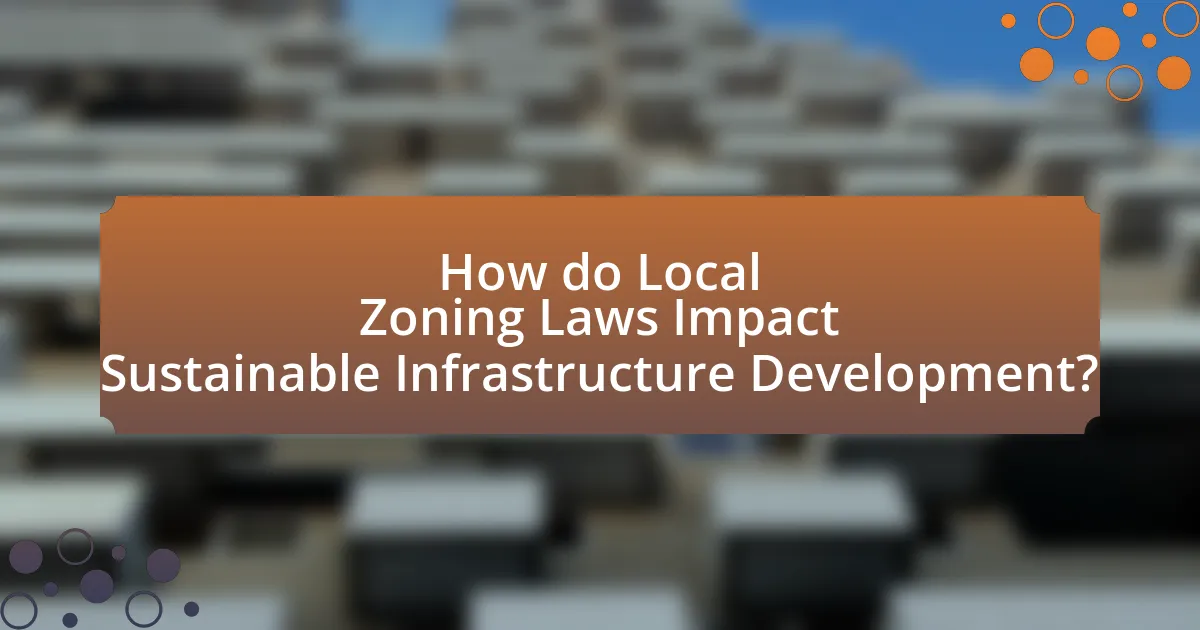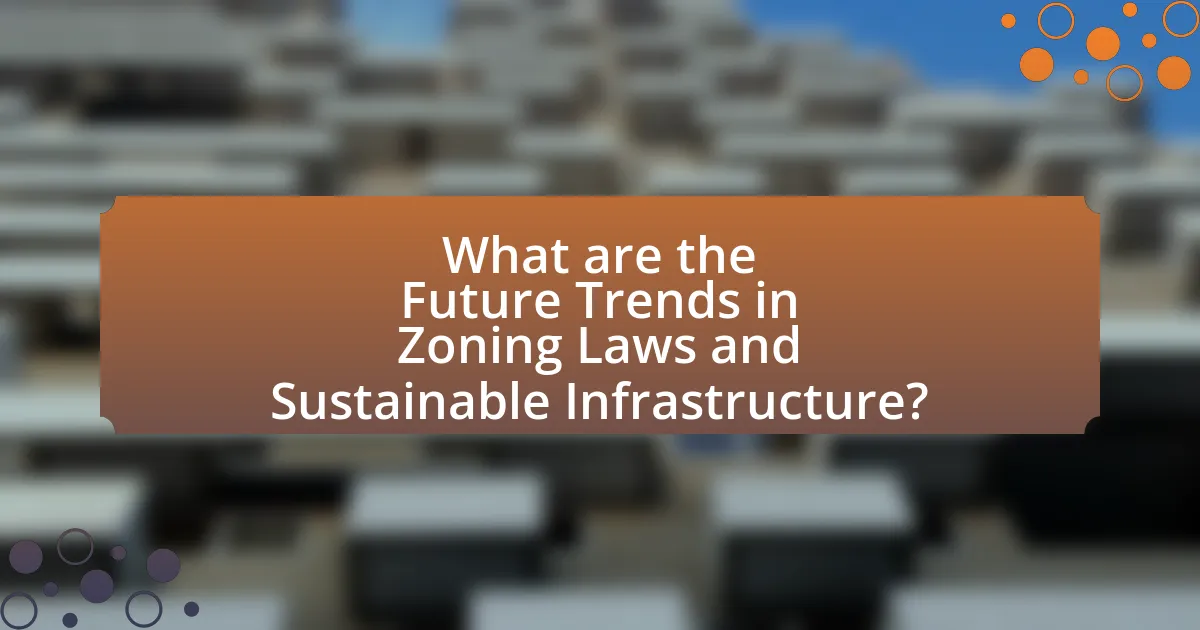Local zoning laws are regulations set by local governments that dictate land use and development within specific areas, aiming to organize urban growth, ensure public safety, and promote community welfare. This article examines how these laws influence land use, property values, and sustainable infrastructure development by regulating various zoning classifications, such as residential, commercial, and industrial. It highlights the importance of zoning in promoting environmental sustainability, resource management, and community planning, while also addressing the challenges posed by restrictive zoning practices. Additionally, the article explores future trends in zoning laws, innovative practices globally, and the role of technology and community engagement in enhancing zoning effectiveness for sustainable development.

What are Local Zoning Laws and Their Purpose?
Local zoning laws are regulations established by local governments to dictate land use and development within specific areas. Their primary purpose is to organize urban growth, ensure public safety, and promote the welfare of the community by controlling the types of activities that can occur in designated zones, such as residential, commercial, or industrial. For instance, zoning laws can prevent incompatible land uses, such as placing a factory next to a residential neighborhood, thereby protecting property values and quality of life. Additionally, these laws can guide sustainable infrastructure development by encouraging environmentally friendly practices and efficient land use, as seen in cities that implement zoning for green spaces and mixed-use developments.
How do local zoning laws influence land use and development?
Local zoning laws significantly influence land use and development by regulating how land can be utilized, determining the types of buildings allowed, and establishing density and design standards. These laws dictate whether areas are designated for residential, commercial, industrial, or agricultural use, thereby shaping the physical and economic landscape of communities. For instance, a study by the American Planning Association found that zoning regulations can directly affect property values and the availability of housing, as they control the supply of land for various uses. Additionally, zoning laws can promote sustainable development by encouraging mixed-use developments and preserving green spaces, which are essential for environmental health and community well-being.
What are the different types of zoning classifications?
The different types of zoning classifications include residential, commercial, industrial, agricultural, and mixed-use zoning. Residential zoning is designated for housing and can vary in density, such as single-family or multi-family units. Commercial zoning is intended for business activities, including retail and office spaces. Industrial zoning is allocated for manufacturing and production facilities. Agricultural zoning is focused on farming and related activities, while mixed-use zoning allows for a combination of residential, commercial, and sometimes industrial uses within a single area. These classifications are essential for urban planning and development, as they dictate land use and help manage growth in a sustainable manner.
How do zoning laws affect property values and community planning?
Zoning laws significantly influence property values and community planning by regulating land use, density, and development types. These regulations can enhance property values in areas designated for commercial or residential development, as they create a structured environment that attracts investment and promotes growth. Conversely, restrictive zoning can lower property values by limiting development potential and reducing the attractiveness of an area for buyers and investors. For instance, a study by the National Bureau of Economic Research found that zoning regulations can lead to a 20% increase in property values in well-planned communities, demonstrating the direct correlation between zoning laws and economic outcomes. Additionally, effective zoning contributes to community planning by ensuring that land use aligns with the community’s vision, promoting sustainable infrastructure development and enhancing quality of life for residents.
Why are zoning laws important for sustainable infrastructure development?
Zoning laws are crucial for sustainable infrastructure development because they regulate land use, ensuring that urban growth aligns with environmental sustainability and community needs. By designating specific areas for residential, commercial, and industrial purposes, zoning laws help prevent urban sprawl, protect natural resources, and promote efficient land use. For instance, a study by the American Planning Association found that effective zoning can reduce vehicle miles traveled by 20-30%, thereby decreasing greenhouse gas emissions and improving air quality. This demonstrates that zoning laws not only shape the physical landscape but also play a significant role in fostering sustainable practices within urban environments.
How do zoning regulations promote environmental sustainability?
Zoning regulations promote environmental sustainability by controlling land use and encouraging development patterns that minimize ecological impact. These regulations often mandate green spaces, protect natural resources, and promote mixed-use developments, which reduce reliance on automobiles and lower carbon emissions. For instance, zoning laws can require the preservation of wetlands and forests, which serve as critical habitats and carbon sinks. Additionally, studies show that communities with stringent zoning regulations experience less urban sprawl, leading to more efficient land use and reduced habitat destruction.
What role do zoning laws play in resource management?
Zoning laws play a critical role in resource management by regulating land use to ensure sustainable development and efficient resource allocation. These laws dictate how land can be utilized, influencing the distribution of residential, commercial, and industrial areas, which directly impacts resource consumption patterns. For instance, zoning can promote higher density housing in urban areas, reducing sprawl and preserving natural resources. According to the American Planning Association, effective zoning can lead to reduced infrastructure costs and improved environmental outcomes by concentrating development and minimizing the need for extensive transportation networks.

How do Local Zoning Laws Impact Sustainable Infrastructure Development?
Local zoning laws significantly influence sustainable infrastructure development by dictating land use, density, and building regulations. These laws can either promote or hinder the integration of sustainable practices, such as renewable energy installations and green building designs. For instance, zoning regulations that encourage mixed-use developments can reduce reliance on automobiles, thereby lowering carbon emissions. Conversely, restrictive zoning can limit the types of sustainable projects that can be implemented, such as prohibiting the construction of energy-efficient buildings in certain areas. Studies have shown that cities with progressive zoning policies, like Portland, Oregon, have successfully implemented sustainable infrastructure projects, demonstrating the critical role of local zoning laws in shaping environmental outcomes.
What are the challenges posed by zoning laws to sustainable infrastructure?
Zoning laws pose significant challenges to sustainable infrastructure by restricting land use and development patterns that promote environmental sustainability. These regulations often prioritize single-use zoning, which can lead to urban sprawl, increased vehicle dependency, and inefficient land use. For instance, a study by the American Planning Association found that traditional zoning practices can hinder mixed-use developments that are essential for reducing carbon footprints and enhancing community resilience. Additionally, zoning laws may impose height and density restrictions that limit the construction of energy-efficient buildings and renewable energy installations, further obstructing sustainable infrastructure goals.
How can restrictive zoning hinder green building initiatives?
Restrictive zoning can hinder green building initiatives by limiting the types of sustainable construction methods and materials that can be used in specific areas. For instance, zoning laws may impose strict height restrictions, setback requirements, or land use designations that do not accommodate innovative designs or eco-friendly technologies, such as green roofs or solar panels. According to a study by the American Planning Association, overly restrictive zoning can stifle the development of energy-efficient buildings and reduce the overall potential for sustainable urban growth. This limitation can lead to increased construction costs and discourage developers from pursuing green building certifications, ultimately undermining efforts to promote environmentally responsible development.
What are the implications of zoning laws on renewable energy projects?
Zoning laws significantly influence renewable energy projects by dictating where and how these projects can be developed. These regulations can either facilitate or hinder the establishment of renewable energy facilities, such as solar farms and wind turbines, depending on the designated land use categories. For instance, restrictive zoning can limit the areas available for renewable energy installations, thereby increasing project costs and extending timelines. Conversely, supportive zoning can streamline permitting processes and encourage investment in sustainable infrastructure. According to a study by the National Renewable Energy Laboratory, effective zoning policies can enhance the deployment of renewable energy technologies by aligning local land use with energy goals, demonstrating that well-structured zoning laws are crucial for the successful integration of renewable energy projects into communities.
How can zoning laws be adapted to support sustainable practices?
Zoning laws can be adapted to support sustainable practices by incorporating regulations that promote mixed-use development, green spaces, and renewable energy installations. These adaptations encourage higher density living, reducing urban sprawl and minimizing transportation emissions. For instance, cities like Portland, Oregon, have successfully implemented zoning changes that prioritize eco-friendly building designs and integrate parks within urban areas, leading to improved air quality and enhanced community well-being. Additionally, allowing for the installation of solar panels and wind turbines in residential zones can significantly increase the use of renewable energy, aligning local policies with sustainability goals.
What are examples of successful zoning reforms for sustainability?
Successful zoning reforms for sustainability include the implementation of mixed-use zoning in cities like Portland, Oregon, which promotes walkability and reduces reliance on cars. This reform has led to a 20% increase in public transit use and a significant reduction in greenhouse gas emissions. Another example is the adoption of form-based codes in Miami, Florida, which prioritize building design and public space over land use, resulting in enhanced community engagement and improved urban aesthetics. Additionally, San Francisco’s zoning changes to allow for more affordable housing developments have contributed to a 30% increase in housing stock while promoting sustainable living practices. These examples demonstrate how targeted zoning reforms can effectively support sustainability goals in urban environments.
How can community engagement influence zoning law changes?
Community engagement can significantly influence zoning law changes by providing local residents a platform to voice their needs and preferences, which can lead to more responsive and adaptive zoning regulations. When communities actively participate in the planning process, they can highlight specific issues such as housing affordability, environmental concerns, and infrastructure needs, prompting local governments to reconsider existing zoning laws. For instance, studies have shown that areas with high levels of community involvement often see zoning adjustments that reflect the desires of residents, such as increased density for affordable housing or the preservation of green spaces. This participatory approach not only fosters transparency but also enhances the legitimacy of zoning decisions, ultimately leading to more sustainable and equitable urban development.

What are the Future Trends in Zoning Laws and Sustainable Infrastructure?
Future trends in zoning laws and sustainable infrastructure include increased flexibility in zoning regulations to accommodate mixed-use developments, the integration of green building standards, and the promotion of transit-oriented development. These trends are driven by the need for sustainable urban growth and climate resilience. For instance, cities like Portland and San Francisco have adopted form-based codes that prioritize walkability and environmental sustainability, reflecting a shift towards more adaptive zoning practices. Additionally, the implementation of policies that incentivize renewable energy installations and sustainable land use practices is becoming more common, as evidenced by the growing number of municipalities adopting sustainability-focused zoning amendments.
How are cities evolving their zoning laws to meet sustainability goals?
Cities are evolving their zoning laws to meet sustainability goals by implementing mixed-use developments, increasing density in urban areas, and promoting green building practices. These changes facilitate reduced reliance on automobiles, enhance public transportation access, and encourage walkability, which collectively contribute to lower carbon emissions. For instance, cities like Portland and San Francisco have adopted policies that allow for higher density housing near transit hubs, effectively reducing urban sprawl and preserving green spaces. Additionally, many municipalities are integrating sustainability criteria into their zoning codes, such as mandating energy-efficient building standards and the inclusion of green roofs. These adaptations reflect a growing recognition of the need for urban planning that prioritizes environmental health and resilience against climate change.
What innovative zoning practices are being implemented globally?
Innovative zoning practices being implemented globally include form-based codes, which prioritize building form and public space over land use, and mixed-use zoning, which encourages diverse uses within a single area. These practices aim to enhance walkability, reduce reliance on cars, and promote sustainable urban development. For instance, cities like Miami and San Francisco have adopted form-based codes to create vibrant, pedestrian-friendly environments, while places like Portland have successfully implemented mixed-use zoning to foster community interaction and economic vitality. These approaches are supported by research indicating that such zoning reforms can lead to improved environmental outcomes and increased social cohesion.
How can technology enhance zoning law effectiveness for sustainability?
Technology can enhance zoning law effectiveness for sustainability by utilizing data analytics, geographic information systems (GIS), and smart city technologies to inform decision-making and streamline processes. Data analytics allows for the assessment of land use patterns and environmental impacts, enabling policymakers to create more informed zoning regulations that promote sustainable practices. Geographic information systems provide visual representations of land use, helping stakeholders understand spatial relationships and make better zoning decisions. Smart city technologies, such as IoT sensors, can monitor environmental conditions in real-time, allowing for adaptive zoning regulations that respond to changing circumstances. These technological tools collectively improve the precision and responsiveness of zoning laws, ultimately fostering sustainable infrastructure development.
What best practices should be considered for aligning zoning laws with sustainable infrastructure development?
Best practices for aligning zoning laws with sustainable infrastructure development include integrating sustainability criteria into zoning regulations, promoting mixed-use developments, and ensuring community engagement in the planning process. Integrating sustainability criteria helps to prioritize environmentally friendly practices, such as energy efficiency and reduced carbon footprints, in new developments. Promoting mixed-use developments encourages walkability and reduces reliance on automobiles, which can lead to lower greenhouse gas emissions. Community engagement ensures that the needs and preferences of residents are considered, fostering support for sustainable initiatives. These practices are supported by studies indicating that communities with integrated zoning and sustainability measures experience improved environmental outcomes and enhanced quality of life.
How can stakeholders collaborate to improve zoning regulations?
Stakeholders can collaborate to improve zoning regulations by forming coalitions that include local governments, community organizations, developers, and residents. These coalitions can facilitate open dialogues to identify common goals, share resources, and develop comprehensive plans that reflect community needs and sustainability objectives. For instance, the American Planning Association emphasizes the importance of stakeholder engagement in the planning process, which can lead to more effective and equitable zoning outcomes. By leveraging diverse perspectives and expertise, stakeholders can create zoning regulations that promote sustainable infrastructure development while addressing local concerns.
What resources are available for communities seeking to reform zoning laws?
Communities seeking to reform zoning laws can access various resources, including local government planning departments, nonprofit organizations focused on land use, and legal aid services specializing in zoning issues. Local government planning departments provide guidance on existing zoning regulations and the reform process, while nonprofit organizations, such as the American Planning Association, offer tools, case studies, and best practices for effective zoning reform. Legal aid services can assist communities in understanding their rights and navigating the legal complexities of zoning changes. These resources collectively empower communities to advocate for zoning reforms that support sustainable infrastructure development.
